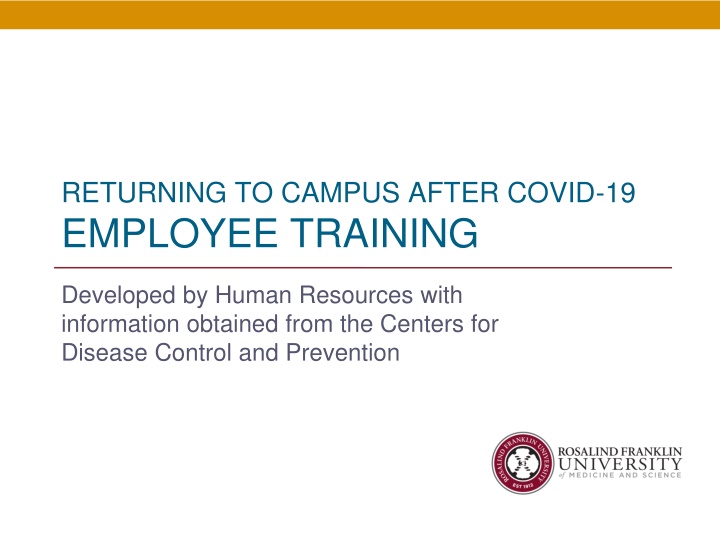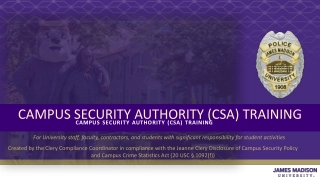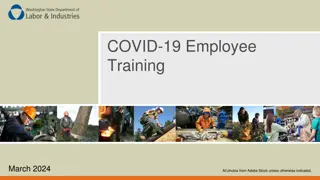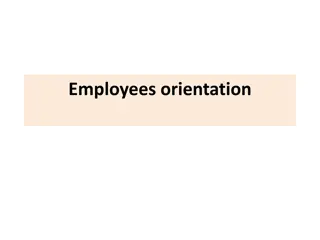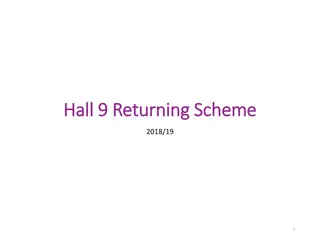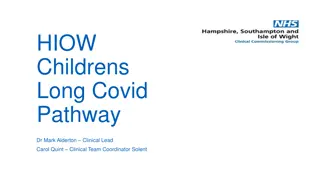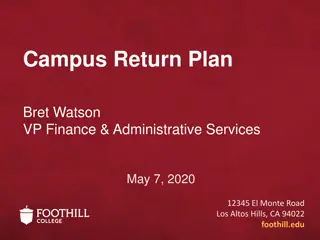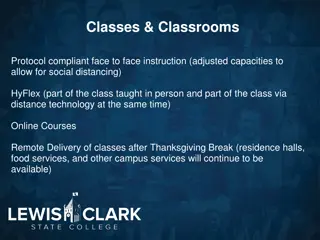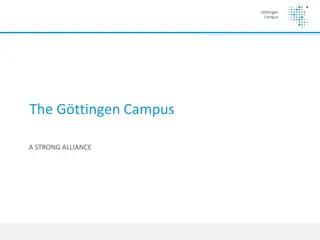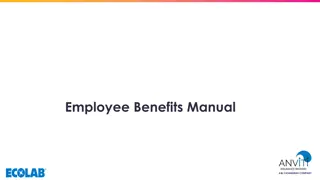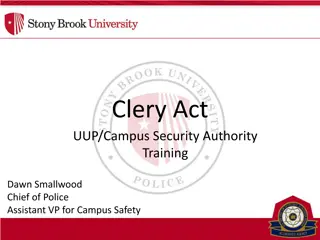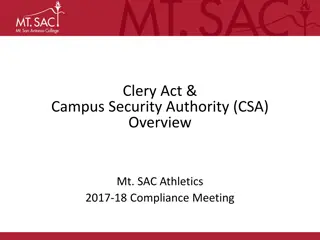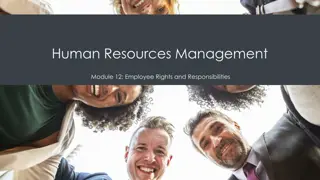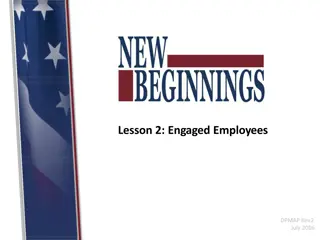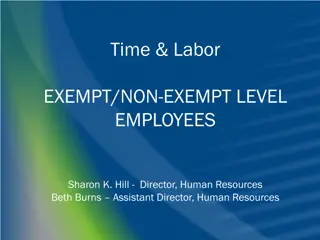Returning to Campus After COVID-19: Employee Guidelines
Rosalind Franklin University provides comprehensive guidelines for employees returning to campus post-COVID-19. The guidelines emphasize maintaining physical distance, hygiene practices, disinfection of surfaces, and the use of masks in public spaces. Employees are encouraged to follow these protocols to ensure a safe working environment.
Download Presentation

Please find below an Image/Link to download the presentation.
The content on the website is provided AS IS for your information and personal use only. It may not be sold, licensed, or shared on other websites without obtaining consent from the author.If you encounter any issues during the download, it is possible that the publisher has removed the file from their server.
You are allowed to download the files provided on this website for personal or commercial use, subject to the condition that they are used lawfully. All files are the property of their respective owners.
The content on the website is provided AS IS for your information and personal use only. It may not be sold, licensed, or shared on other websites without obtaining consent from the author.
E N D
Presentation Transcript
RETURNING TO CAMPUS AFTER COVID-19 EMPLOYEE TRAINING Developed by Human Resources with information obtained from the Centers for Disease Control and Prevention
Returning to Campus Rosalind Franklin University is committed to supporting the health and safety of the faculty and staff. To protect you and all employees, the following document must be read in its entirety. This will ensure an understanding of the university s expectations of you as we continue to recover from the pandemic. 2
Distancing and Hygiene Guidelines Facilities Management will continue providing multiple daily cleaning and disinfecting of classrooms, breakrooms, bathrooms and public spaces. Additionally, all employees will be required to exercise caution and continue physical distancing and personal hygiene practices in order to protect from the spread of the coronavirus as per the guidelines below. 3
Expectations of Employees Faculty and staff should limit close personal contact and maintain a minimum 6 feet of distance apart. Faculty and staff in individual offices should consider working with office doors shut. No more than two persons in an office and for no longer than 10 minutes. 4
Expectations of Employees Faculty and staff should engage in frequent hand washing, the use of hand sanitizer and sanitizing of surfaces regularly. Wash hands with soap and water for at least 20 seconds as frequently as feasible. Use hand sanitizer after interactions with people or objects, if soap and water are not readily available. Cover coughs and sneezes into the sleeve or elbow, not hands. 5
Expectations of Employees Clean and disinfect high-touch surfaces (buttons, door handles, counters, workstations, keyboards, telephones, handrails, etc.) regularly. Facilities will provide disinfecting wipes or sprays for computer labs, classrooms and public spaces for individuals to clean surfaces regularly. Avoid touching your face. Refrain from shaking hands. Hand sanitizing stations are available throughout the campus. Use them liberally. 6
Expectations of Employees Faculty and staff are required to wear cloth masks in public spaces and must wear them any time they cannot maintain a safe physical distance from others. Faculty and staff should avoid using other employees phones, desks, offices or other work tools and equipment when possible. If necessary, clean and disinfect them before and after use. Obey directional signage for hallways and stairwells. Many will be one-way when we return to campus. 7
Expectations of Employees Faculty and staff should remain mindful of physical distancing in small spaces including elevators, hallways, stairwells and restrooms. One person at a time in an elevator must be adhered to for physical distancing. Faculty and staff should eat in a location that allows for appropriate physical distancing (outdoors, in an enclosed or private space, in an office with the door closed, etc.). All visitors to campus, including contractors, vendors, guest speakers, etc., will be expected to follow these guidelines. 8
Expectations of Employees Faculty and staff should limit the number of people at gatherings. Examples include: When in-person meetings are necessary, no more than the number of people defined in the governor s order should be present, and physical distancing should be maintained. The current limit is 10 people. Video conferencing and conference calls should be used instead of in-person meetings as often as possible. 9
Expectations of Employees No events, meetings or gatherings will be approved that include more than what the governor s order defines. Please note that the multi-person limit on gatherings includes other personnel that may be present in that space. Room capacity limits will be posted for all classrooms. Encourage Telework 10
Expectations of Employees Work from home whenever possible. Limit your time on campus. When necessary to report to work, discuss scheduling with your supervisor to ensure physical distancing guidelines are followed. If you or a member of your household is immunocompromised: Report your concern to HR. Work with HR and your supervisor to limit on-campus exposure and continue work from home activities as much as possible for your position. 11
Expectations of Employees with COVID-19 symptoms or with a sick family member at home with COVID-19 Employees who have symptoms such as fever, cough or shortness of breath should notify their supervisor, contact their healthcare provider, complete the exposure/illness report on the university s COVID website page and stay home until symptoms subside and they ve been advised to return to work. Employees with confirmed cases of COVID-19 should follow the CDC guidelines and university protocol, and should not return to work until they are released by HR. 12
Expectations of Employees with COVID-19 symptoms or with a sick family member at home with COVID-19 Employees who are well but who have a family member at home sick with a confirmed case of COVID-19 should notify their supervisor. Complete the exposure/illness report on the university s COVID webpage. Follow CDC recommended precautions and stay at home until released by HR to return to the office. 13
Preventing Getting Sick HOW IT SPREADS The virus is thought to spread mainly from person-to-person: Between people who are in close contact with one another (within about 6 feet). Through respiratory droplets produced when an infected person coughs, sneezes or talks. These droplets can land in the mouths or noses of people who are nearby or possibly be inhaled into the lungs. 14
Protect Yourself: Use of Masks Faculty and staff must wear masks in public spaces and must wear them any time they cannot maintain a safe physical distance from others. Please review the following pages from the CDC website: https://www.cdc.gov/coronavirus/2019-ncov/prevent- getting-sick/about-face-coverings.html https://www.cdc.gov/coronavirus/2019-ncov/prevent- getting-sick/how-to-wear-cloth-face-coverings.html 15
When to Wear Gloves For the general public, CDC recommends wearing gloves when you are cleaning or caring for someone who is sick. In most other situations, like running errands, wearing gloves is not necessary. Practice everyday preventive actions like keeping social distance (at least 6 feet) from others, washing your hands with soap and water for 20 seconds (or using a hand sanitizer with at least 60% alcohol), and wearing a cloth face covering when you have to go out in public. 16
Social Distancing Social distancing, also called physical distancing, means keeping space between yourself and other people outside of your home. To practice social or physical distancing: Stay at least 6 feet (about 2 arm lengths) from other people. Do not gather in groups. Stay out of crowded places and avoid mass gatherings. The CDC discourages use of public transportation. 17
Social Distancing In addition to everyday steps to prevent COVID-19, keeping space between you and others is one of the best tools we have to avoid being exposed to this virus and slowing its spread locally and across the country and world. Limit close contact with others outside your household in indoor and outdoor spaces. Since people can spread the virus before they know they are sick, it is important to stay away from others when possible, even if you or they have no symptoms. Social distancing is especially important for people who are at higher risk for severe illness from COVID-19. 18
If you are sick with COVID-19 Stay home. Most people with COVID-19 have mild illness and can recover at home without medical care. Do not leave your home, except to get medical care. Do not visit public areas. Take care of yourself. Get rest and stay hydrated. Take over-the-counter medicines such as acetaminophen to help you feel better. Stay in touch with your doctor. Call before you get medical care. Be sure to get care if you have trouble breathing, or if you think it is an emergency. Avoid public transportation. 19
If you are sick with COVID-19 As much as possible, stay in a specific room and away from other people and pets in your home. If possible, you should use a separate bathroom. If you need to be around other people or animals in or outside of the home, wear a cloth face covering. Monitor your symptoms and follow the care instructions from your healthcare provider and local health department. File an exposure/illness report on the university s COVID-19 webpage and receive guidance on next steps from HR. 20
Resources https://www.cdc.gov/coronavirus https://www.rosalindfranklin.edu/covid19/ https://www.cdc.gov/coronavirus/2019- ncov/daily-life-coping/using-transportation.html 21
Daily Screening Module All Students, Faculty, and staff are required to complete a daily health screening module and show verification of completion of this screening tool upon entering the facilities. The module has been developed by Apple and the CDC. The screening module is available as an app for download to your smart device .Apple Covid-19 .or You can access the screening tool via the internet at: www.apple.com/covid-19 The message at the end of the screening signifying clearance will be similar to this: No Test Needed At This Time As of now, your answers suggest you do not need to get tested for COVID-19. If anything changes, take the questionnaire again. Completed June 10, 2020, 11:40 AM
Acknowledgement of Risk Return to RFU Campus In anticipation of my return to the Rosalind Franklin University (RFU) campus, I have successfully completed the virtual training course provided by RFU about the proper use of personal protective equipment (PPE) and other precautions to take to guard against the SARS-CoV-2 virus infection (COVID-19). I acknowledge that this training is designed to help preserve my health, as well as to safeguard the health of others with whom I may be in contact. I fully recognize that there are a wide range of risks associated with COVID-19 and that this is a novel virus and other risks may also exist that have not yet been identified. I acknowledge that it is my responsibility to ensure that I properly use PPE and adhere to the other precautions in my efforts to preserve my health, as well as to safeguard the health of others with whom I may be in contact. Printed Name Signature Date Signed Please print and sign this form and send to HR, or email to hr@rosalindfranjklin.edu your acknowledgment of completion of this module and acknowledgement of risk and responsibility. 23
WERE ALL IN THIS TOGETHER Thank you for all your efforts to stay healthy and safe and to ensure the safety of others!
